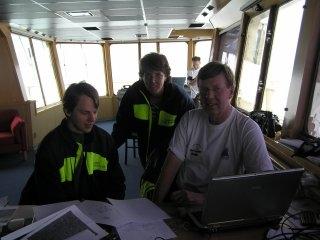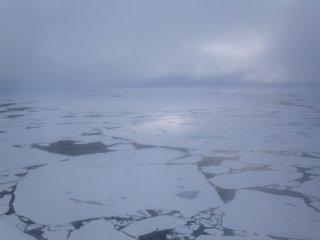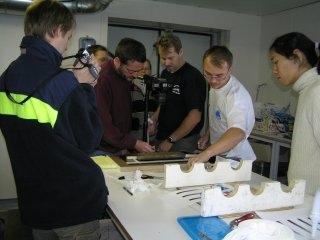17 August, 2004
The first samples from ACEX arrive in the lab.
Some preliminary sediment arrived in the main lab of the Oden on deck 1
yesterday, although this was not the first real sediment sample from the
seabed that all are waiting for. It was very exciting to see everyone spring
into action to take a look at what arrived. The paparazzi crowded around
anxious to record the moment with digital cameras, still cameras and video
cameras. We all had to be patient while the core sample was carefully
measured, officially photographed and the physical attributes noted. Then it
was time for the scientists to all get their "little piece of the mud" to
examine with the microscope. I can only imagine what the scene will be like
when the real thing is brought aboard.
It seems as if we'll have to wait for the official sediments because there
have been some mechanical problems with the drilling equipment. I keep
reminding myself that it is a very technologically sophisticated operation
to drop a drill line down into 1100-1200 km of ocean water and then drill
500 meters into the seafloor. And this extent of drilling has never been
attempted or accomplished here in the tough Arctic environment with such
thick ice, so we must be patient as the operation proceeds.
Drilling is the main concern on the Vidar Viking while here on Oden ice
management is the name of the game. It is critical to the operation that we
know exactly what the ice conditions are and even more importantly how they
might change in order for safe and effective drilling to take place. Erik
and I spend a lot of time talking to the ice team; ice management is such a
new concept to me and everyday I learn lots of new things. I find it is a
nice time to catch up on ice when I go up to the bridge just before
breakfast. Even that early in the morning, lots is happening. Ice recon
missions are flown anytime of day or night and with 24 hours of daylight,
time often seems an illusion. It is not unusual to see the scientists
looking over data from a 4 am ice flight. The helicopter pilots must get
used to being called out of bed whenever the cloud cover and fog lifts
enough for flying.
We had an unusually quiet night last night as the ship was not doing its
usual icebreaking. While they work out the drill problems, Vidar and Oden
are just drifting with the ice floes but the Soyuz continues to cruise
around in crazy convoluted motions, plowing through the ice. On satellite
pictures of the ice situation, the Soyuz's tracks look like a big bowl of
spaghetti. To continue with the food comparisons, I was surprised to know
that ice chart symbols are actually referred to "egg codes"! The data on ice
coverage and ice development is coded and displayed in on the charts in
small ovals. Reading ice charts, like in many other science disciplines, is
a lot like reading another language. I'm surprised at how quickly I pick up
the lingo and can easily join in the conversation. I'll have much to teach
the Pier School students about ice when I return. Of course I'd better bring
lots of photos because we do not get much sea ice in Narragansett Bay unless
it's an unusually cold winter. There have been some very beautiful and
artistic photographs taken of the ice by many on the expedition and
fortunately most photographers are willing to share their images - so even
if my own pictures are mediocre I'll have some wonderful pictures to show.
I've included one ice picture here that I took on the ice reconnaissance
flight a couple days ago.

Erik, Kathy and Arno Keinonen of the Ice Management Team.

Arctic ice as seen from the helicopter on ice reconnaissance flight.

Everyone is excited about the preliminary sediment samples.
Contact the TEA in the field at
.
If you cannot connect through your browser, copy the
TEA's e-mail address in the "To:" line of
your favorite e-mail package.
|
